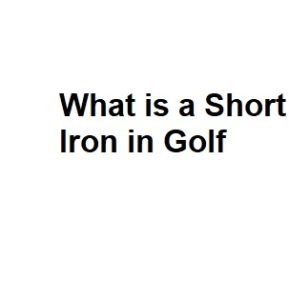Golf, a sport that demands precision and skill, is played with a set of clubs designed for various distances and scenarios. Short irons are a crucial subset of golf clubs that play a significant role in a golfer’s game. In this article, we will explore what short irons are, their characteristics, and how they fit into the golfer’s toolkit.
Introduction to Short Irons
Short irons are a subset of irons in a golfer’s bag, typically comprising the 8-iron, 9-iron, and pitching wedge (PW). These clubs are known for their lofted faces and shorter shafts compared to long irons and woods, making them ideal for shorter distance shots and precise control.
Characteristics of Short Irons
a. Lofted Faces: Short irons have highly lofted faces, which means the clubface has a significant angle relative to the shaft. This loft generates more vertical lift on the golf ball when struck, making it easier to achieve a higher trajectory and a softer landing on the green.
b. Shorter Shafts: Compared to long irons and woods, short irons have shorter shafts. The shorter shafts provide greater control over the clubhead and enable golfers to make more accurate and controlled swings.
c. Versatility: Short irons are versatile clubs that can be used for a variety of shots, including approach shots to the green, chip shots, and bunker shots. They are essential for golfers when they need to make precise, shorter-distance shots.
Uses of Short Irons
a. Approach Shots: One of the primary uses of short irons is for approach shots to the green. Golfers often use an 8-iron, 9-iron, or PW to target the green from a distance where precision is critical. These clubs provide the necessary loft to stop the ball quickly on the putting surface.
b. Chipping: Short irons, especially the pitching wedge, are frequently used for chipping around the green. Golfers can employ a putting-like stroke with these clubs to get the ball rolling smoothly towards the hole.
c. Bunker Play: In greenside bunkers, short irons can be used to get the ball out of the sand and onto the green. The lofted face helps lift the ball out of the bunker’s soft sand while maintaining control.
Club Selection and Strategy
Selecting the appropriate short iron depends on the golfer’s distance to the target and the height and trajectory required. Golfers should consider factors such as wind, pin placement, and green conditions when choosing a short iron for their shot.
Practice and Skill Development
To excel in using short irons effectively, golfers need to practice consistently. This includes mastering distance control, accuracy, and understanding how each short iron behaves in different situations. Proper technique and a solid understanding of how to play short irons can significantly improve a golfer’s overall game.
Short Iron Terminology
Before concluding, let’s briefly explore some golf terminology associated with short irons:
- Scoring Clubs: Short irons, including the 8-iron, 9-iron, and pitching wedge, are often referred to as “scoring clubs” because they are instrumental in getting the ball closer to the hole and setting up opportunities for birdies or pars.
- Gapping: Gapping refers to the yardage intervals between each of your short irons. Golfers aim to have consistent gaps to ensure they have the right club for various distances. For example, knowing your 8-iron carries 140 yards and your 9-iron carries 125 yards helps you make informed club selections for specific shots.
Types of Short Irons
| Type of Short Iron | Loft Angle (degrees) | Typical Distance (yards) | Use Case | Characteristics |
|---|---|---|---|---|
| Pitching Wedge | 44-48 | 90-120 | Approach shots, chipping | High loft, versatile |
| Gap Wedge (Approach Wedge) | 50-54 | 80-110 | Approach shots, filling distance gap | Mid-range loft |
| Sand Wedge | 54-58 | 70-100 | Bunker shots, short approaches | High loft, bunker-specific |
| Lob Wedge | 58-64 | 60-80 | Flop shots, tight lies | Extreme loft, delicate shots |
| Approach Putter | Varies | Varies | Putting from the fringe | Longer putter shaft |
Loft Angles of Short Irons
| Iron Type | Loft Angle (degrees) |
|---|---|
| Pitching Wedge | 44-48 |
| Gap Wedge | 50-54 |
| Sand Wedge | 54-58 |
| Lob Wedge | 58-64 |
| Approach Putter | Varies |
Typical Distances for Short Irons
| Iron Type | Typical Distance (yards) |
|---|---|
| Pitching Wedge | 90-120 |
| Gap Wedge | 80-110 |
| Sand Wedge | 70-100 |
| Lob Wedge | 60-80 |
| Approach Putter | Varies |
Short Iron Use Cases
| Iron Type | Primary Use Case |
|---|---|
| Pitching Wedge | Approach shots, chipping |
| Gap Wedge | Approach shots, filling distance gap |
| Sand Wedge | Bunker shots, short approaches |
| Lob Wedge | Flop shots, tight lies |
| Approach Putter | Putting from the fringe |
Characteristics of Short Irons
| Iron Type | Characteristics |
|---|---|
| Pitching Wedge | High loft, versatile |
| Gap Wedge | Mid-range loft |
| Sand Wedge | High loft, bunker-specific |
| Lob Wedge | Extreme loft, delicate shots |
| Approach Putter | Longer putter shaft, designed for fringe use |
Conclusion
In conclusion, short irons are indispensable clubs in a golfer’s bag, designed for precision and control on the golf course. They are characterized by lofted faces, shorter shafts, and versatility, making them ideal for approach shots, chipping, and bunker play. Understanding when and how to use short irons effectively is key to improving your golf game and achieving lower scores. As with any aspect of golf, practice and skill development are essential for mastering the use of these clubs and becoming a more proficient golfer.



